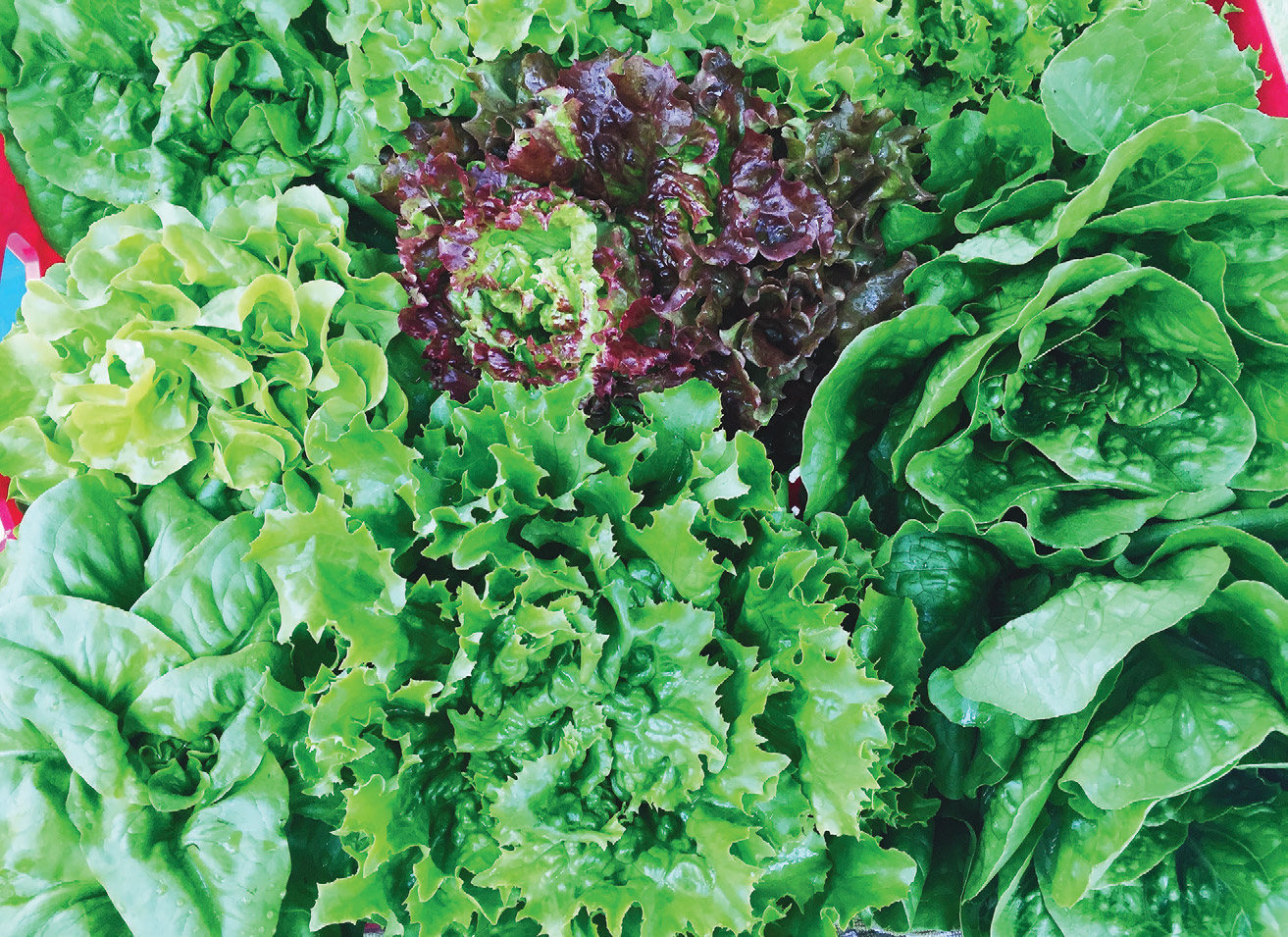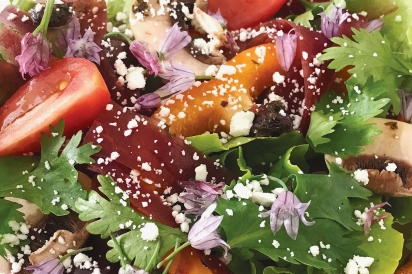A Wedge of History
The “Grande Sallet”
Once a lowly roadside weed, lettuce now graces the dinner plates of people worldwide. Lettuce began its journey of domestication first as a valued medicinal plant but soon found itself on the menus of kings and queens, emperors and common people alike. Its wild predecessors had pierced the pant legs of passers-by for millennia unnoticed. How did it happen that such an unimposing plant was chosen over chicory, dandelion or other weeds by ancient man to become the king of the salad bowl?
The diversity within the genetic structure of lettuce has everything to do with it, as does its ability to change and evolve according to its environment. The dandelion, for example, is locked into an evolutionary “cul-de-sac” by its non-deviating reproductive system, surviving to become a noxious weed but little else. Lettuce, on the other hand, in spite of being a self-fertilizing species, need not be an evolutionary dead end. That self-fertilizing condition was derived from distant cross-pollinating ancestors still able to produce many mutations and combinations. Within its genome, lettuce displays an enormous adaptability of a peculiar kind, enabling it to make changes due not only to its genes but its environment as well. This results in an endless array of variation, size, shape, color and texture as well as the variable arrangement of the leaves on the stem, creating lettuce types as varied as romaine or butterhead. This is what caught the eye of the first ancient plant breeders when they plucked this weed from the roadside and began growing it in their gardens.
The Egyptians are believed to be the first ancient breeders and domesticators of wild lettuce through depictions of the plant in paintings on the walls of the great tombs of Egypt dated around 4500 B.C. They show a lettuce similar to our modern-day romaine. Though originally used as a medicinal herb and sacred plant, it was best known for its narcotic properties, stemming chiefly from ancient observations that it rendered one sleepy after eating “old” lettuce.
The ancient Greeks greatly valued lettuce for this ability to induce sleep, along with its culinary merits. Accordingly, it was served at the end of a meal. The Roman emperor Domitian (81-96 C.E.), an emperor very fond of entertaining, mixed things up a bit to humor himself by serving it at the beginning of meals to put his guests into a stupor. He found great enjoyment watching his guests struggle to stay awake in his royal presence. Today, there is a scientific basis for the Roman emperor Domitian’s folly: lettuce has been proven to contain a sleep-inducing substance called lactucarium.
Since the beginning of man’s culinary appreciation of lettuce, it has reigned supreme in the salad bowl. In the 17th century, raw lettuce dishes were known as herba salata (salted greens) and gave rise to the English word “salad.” Today the word “salad” has become synonymous with lettuce.
In John Evelyn’s cooking and gardening book Aceteria (1699) he referred to lettuce as the principal foundation of all “sallets” and that because of its “cool and refreshing benefits” as well as its medicinal properties, it was held in such high esteem to the ancients that many dignified persons ennobled their names with that of Lactucinii, (Lactuca is the genus name of lettuce). Evelyn saw salad as an essential part of “civilized” society.
The salads of those days would have put to shame our much less enterprising attempts such as the “chef’s salads” of today. In his book Evelyn lists 72 different roots, stalks, leaves, flowers and fruits, picked fresh and steamed, that could be encompassed in the “herba salata”. Potatoes, figs, beets, herbs, lemon, melon, mint, turnip, dandelions, garlic, hops and much more were laid out artistically on the dinner plate. Some cooks of the day went even further, adding pickled oysters and meats while always topped with “acetous juice, oyl and salt”. And although the 17th century became the age of the “grand sallet”, they were still unable to decide whether to serve it at the end or the beginning of a meal.
During the 18th century John Redmond Coxe (1713-1864), a physician and professor of medicine famous for his promotion of the smallpox vaccine, who vaccinated both himself and his infant son to establish public confidence, decided in 1792 to explore the validity of the opiate-like accounts of lettuce used throughout history. He documented his findings in a paper published by the American Philosophical Society in 1799. As both a devoted patriot and as a physician, Coxe believed that America should not be dependent on foreign countries to supply such important commodities as medicines, particularly ones as dangerous as opium, and instead should look within its own borders for better alternatives. “Among the various objects which nature holds up to our view, none are more deserving of investigation than the vegetable kingdom,” he wrote in his journal. Coxe believed we could find better alternatives in our own gardens.
In a study on the subject, he compared the effects of opium poppy (Papaver somniferum) with garden lettuce (Lactuca sativa) by extracting the milky liquid that exudes from both when cut. In his paper he wrote, “In 1792, it occurred to me to try for myself the quality and nature of that milky juice which exudes from this plant in copious streams when wounded; and this I was induced to do from the well-known effects of the plant in causing sleepiness when old; as well as from its peculiar smell and taste. I found similar effects induced upon myself when taken internally in the same doses with opium of the poppy and the milk of the lettuce. The most pleasing sleep was brought on by one grain of the extract as if I had just drunk a glass of wine.”
Lettuce had first arrived in the New World by 1493, and was soon cultivated in the West Indies, making its way to America and being planted in the kitchen gardens of the colonists, where it was used not only as a meal, but also medicinally. Dried balls of lettuce latex were used to treat insomnia in both medieval England and colonial America, and the wild lettuce extract called lactucarium was used as a sedative in hospitals through World War II. By 1806, sixteen cultivars of lettuce were being sold in seed catalogs in America, and in 1885 at the New York Agricultural Experiment station, eighty-three distinct varieties of lettuce were grown under nearly two hundred names. Today hundreds, if not thousands, of varieties exist worldwide.
Historians have long noted the magnitude of colonial New England’s agricultural achievements, yet often make little mention of one of our region’s earliest success stories: the “kitchen garden” where lettuce ruled. Perhaps it was because the term “kitchen garden” suggested a diminutive connotation of being a place where a dutiful housewife tended to a few herbs and flowers, but in fact that image bears little resemblance to reality. Throughout the 17th and 18th centuries, New England families cultivated elaborate kitchen gardens of an acre or more. Their care was allotted to the women and children of the household for growing specialty crops, while the men maintained larger plots on the outskirts of the settlements. Lettuce was an important cottage garden vegetable that could be harvested continuously. Today the “kitchen garden” is having an explosive resurgence and is as important as ever in these times of uncertainty.
Many gardeners struggle with having a continuous harvest of lettuce throughout the changing seasons, but with a little planning and preparation it can be the most productive crop in the garden. Like all crops grown in a small space, soil amendment, rotation and succession plantings are the key to success. You are able to get more value from the area in which lettuce is grown than from any other vegetable crop. A row of watermelon, for instance, is harvested only once at the end of the growing season, while full sized lettuce can be harvested 5-6 times in the same space and in the same growing season. Lettuce is a self-pollinating annual, so it seldom cross pollinates. Because of this you can successfully save seeds each year, helping you to develop plants well adapted to your garden conditions. Lettuce forms a deep taproot with largely horizontal lateral roots that are dense near the soil surface, so mulch your plants well, (they love eel grass or kelp), side dress, and don’t cultivate near the plant and disturb its root system. Choosing varieties suited for different times of year, say heat resistance or cold resistance, will further benefit your success. During the hottest parts of summer, adding a 30% shade cloth suspended at least five feet above the plants will carry most heat tolerant varieties through July and August if their planting is timed so that the plants are still young when hot weather is expected. Lettuces should be spaced 12 inches apart in every direction if you’re planning to harvest at full size. (As soon as a lettuce feels the touch of another plant infringing upon its space or sunlight, it’s a full-out race for procreation and your lettuce will bolt.) Lettuce likes a rich soil high in nitrogen and should be grown and harvested quickly for the most delectable result.
During the golden age of the “grand sallet” nothing was beyond inclusion. Fantastical ingredients were sliced, chopped, shredded or carved, whole, raw, blanched or often pickled. Artichokes, asparagus, basil, beets, borage, mint and nasturtium flowers and leaf, parsley, peppers, celery, purslane, spinach, onions, chives and their florets are only a few of the salad accoutrements relished by the 17th century gourmet. Their gardens were overflowing with both the necessities and specialties of their tables. So why not go wild with your salad this season. Include the important winter salad ingredients in your kitchen gardens this summer to pickle and preserve for your winter salads. Try oranges or lemon, even lime in place of vinegar, or press a whole garlic clove on top of your salad with olive oil and Himalayan pink salt. Take a break from this stressful year, find a little spot of ground, grab your hoe and plant your most exciting kitchen garden this year.
Happy the Man, who from Ambition freed,
A little Garden, little Field does feed.
The Field gives frugal Nature what’s requir’d;
The Garden what’s luxuriously desir’d:
The specious Evils of an anxious Life,
He leaves to Fools to be their endless Strife.







